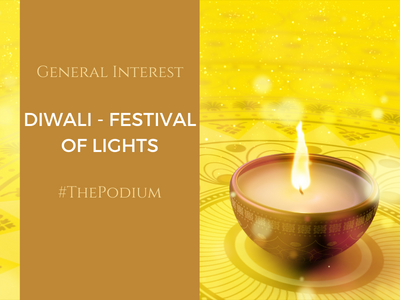
By Christine J. Flores, CBA
A friend of mine gave me a row of lights which are used during Diwali, so I thought I would research it before I light them. Diwali, also spelled Divali, is one of the major religious festivals in Hinduism, Jainism and Sikhism. It is celebrated throughout India, Singapore and several other South Asian countries as a national holiday. It is celebrated in late October and early November. The name is derived from the Sanskrit term dipavali, or “row of lights.” The festival generally symbolizes the victory of light over darkness and good over evil.
Observances of Diwali differ depending on region and tradition. In most of India, the celebration lasts five days with the third day being the main celebration of Diwali. There are some areas where Diwali is celebrated only on the main day. The most widespread custom among Hindus is the lighting of diyas, or small earthenware lamps filled with oil to invite the presence of Lakshmi, the goddess of wealth. In North India the festival also celebrates the royal homecoming of Rama to the city of Ayodhya after defeating Ravana, the 10-headed king of the demons. In South India, the festival marks the defeat of the demon Narakasura. Some celebrate this holiday as a commemoration of the marriage of Lakshmi and Vishnu, while others observe it as Lakshami’s birthday.
During this festival, diyas are lit and placed in rows near temples and houses, and set adrift on rivers and streams. Homes are decorated and floors are covered with elaborate designs made of colored rice, sand, or flower petals. The doors and windows of houses are kept open so that Lakshmi can find her way inside and bless the residents with wealth and success.
Each day of Diwali has a specific purpose. The first day is dedicated to cleaning homes and purchasing small gold items and food for the celebrtation. Lakshmi is the focus of worship on that day. The second day commemorates Krishna’s destruction of Narakasura and it is customary to offer prayers for the souls of ancestors. On the third day families seek blessings from Lakshmi to ensure their prosperity. This is usually the main day of the festival, and candles are lit; and families visit temples. Some believe that fireworks ward off the evil spirits. The fourth day commemorates Krishna’s defeat of Kindra, the king of the gods. This also marks the start of the new year in the Hindu calendar. For some the bond between husband and wife is the theme for the day and husbands will often buy their wives gifts to celebrate. The fifth day celebrates the bond between brothers and sisters, and sisters pray for the success and well-being of their brothers. A central theme of this national holiday is family.
Diwali is celebrated by visiting family, exchanging gifts, wearing new clothes, feasting on sweets and special foods, feeding the poor and with fireworks displays. Gambling is encouraged to ensure good luck in the coming year. Businesses are generally closed or close early to allow employees to celebrate Diwali with their families.
Information on this colorful holiday is readily available on the internet. Here are two links to get you started if you wish to learn more about it.
https://www.almanac.com/content/diwali
https://www.britannica.com/print/article/166786
Categorized in: General
| << previous | next >> |








